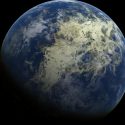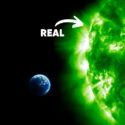Make room, earthling. We’re moving the other planets in our Solar System into our planetary neck of the woods. Would all the planets fit into this Goldilocks zone? What kinds of gravitational chaos would this cause? And could this mean life would exist on the other planets?
Liquid water is a key ingredient for life. And in our Solar System, Earth is the only planet with liquid water on its surface. That’s because our planet is located in the habitable zone of our Sun. This is also known as the Goldilocks zone. And the conditions here are juuuuust right. Any closer, and water would boil away. Any further, it would freeze.
The size of this area depends on how hot or cool a star is. Scientists have discovered 4,000 exoplanets within habitable zones. But only 24 of them might be able to support life. In our Solar System, this zone is within a range of 0.9 to 1.2 AU from the Sun. So if we parked all the other planets within this 45 million km (30 million mi) real estate, could we kickstart extraterrestrial life?
With eight planets to squeeze in the Goldilocks zone, you’d need to get creative. The last thing you’d want to do is disrupt the conditions for life on Earth, right? To start this scenario off, you’d need to move Mercury to the innermost portion of the habitable zone. At around 0.9 AU, that would be more than twice as far away from the Sun as Mercury orbits now.
Not much would change on this rocky planet, except for a refreshing coolness after billions of years of scorching hot temperatures. Venus already orbits relatively close to the habitable zone at 0.72 AU. When our Sun was a young star and dimmer, Venus was essentially located in a habitable zone. It could even have had conditions for life with a shallow ocean of its own.
But as the Sun got hotter, that Goldilocks zone was pushed further back. Temperatures increased, and the oceans boiled away. Maybe re-locating Venus to a cooler spot away from the Sun could make it habitable once again. Now, it would be time to do some calculating. You’ve got five more planets to squeeze in.
It could be a good idea to make sure all the planets are an equal distance apart. With our narrow Goldilocks zone, you could place each planet 6.5 million km (4 million mi) from the other. That would be equal to about 30 times the distance between the Earth and the Moon. Moving us away from our current location would make this whole experiment a little less chaotic. But at about 0.97 AU, things would get warmer here.
Bad news for the climate crisis. Ignoring that for now, you’d move on to Mars. You’d be excited to see if this cold, rocky planet could have life. Sorry to say it would still be barren. Liquid water isn’t the only thing that life needs to thrive. Mars lacks a magnetic field. That means solar radiation would strip away the chances of it having an atmosphere. You’d still have to terraform it.
You’d likely not see any life popping up on the remaining gaseous planets either. The gas giants, Jupiter and Saturn, have atmospheric pressures and temperatures far too intense for molecules like DNA to be stable. But you could probably take a cold dip on one of Jupiter’s moons, Europa. Its new proximity to the Sun would allow its thick ice layer to melt.
Feeling refreshed, you’d realize that the last planet in our Solar System, Neptune, is now even closer to us than Mars is today. That means in our new Solar System arrangement, planet-hopping would be a reasonable adventure. Even with current technology, you could travel between the planets in 90 days. Beyond the exploration, there are all kinds of resources you could extract from the other planets.
You could get hydrogen fuel from Jupiter and Saturn to help us transition to a low-carbon future. You could mine cobalt from asteroids. This would be important to developing renewable energy systems. But this new Solar System would be a little unstable, to say the least. Especially with a massive planet like Jupiter so close to us. It has two and a half times the mass of all the other planets in our Solar System combined.
Scientific reports indicate a star similar to our Sun could have six Earth-sized planets within its habitable zone. With Jupiter, gravitational stability would be all out of whack. And all these imbalances could result in the planet or moons getting ejected from orbit or reshuffled completely. So maybe you’d end up with a messy new order of planets. And life on Earth facing extinction.
Sources
- “What Is The Habitable Zone?”. Swapna Krishna. 2020. planetary.org.
- “Habitable Zone | Astrobiology”. 2022. Jack J. Lissauer. britannica.com.
- “How Many Planets Can Fit Inside A Star’s Habitable Zone?”. Charles Q. Choi. 2016. space.com.
- “What Is An Exoplanet? | NASA Space Place – NASA Science For Kids”. 2022. spaceplace.nasa.gov.
- “Earth is closer to the edge of Sun’s habitable zone” 2013. physicsworld.com.



























